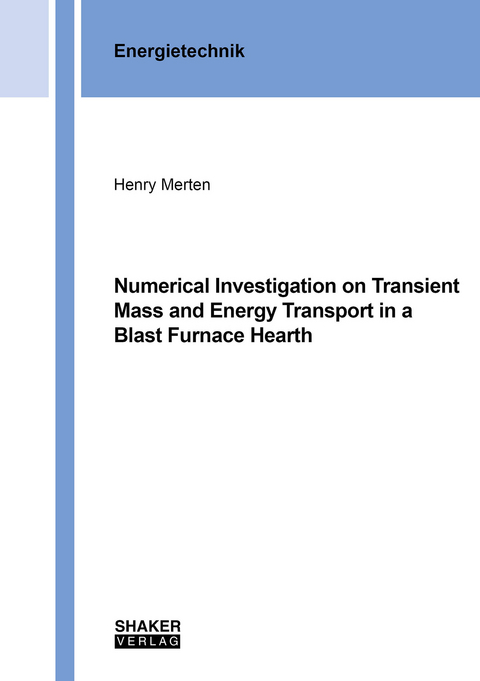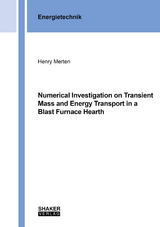Numerical Investigation on Transient Mass and Energy Transport in a Blast Furnace Hearth
Seiten
In blast furnaces, the erosion of refractories in the hearth is widely considered to be the main limitation of the attainable campaign length. Therefore, investigations related to the hot metal flow and its con- nection to refractory wear contribute directly to the economic viability of the process as well as to a safe and reliable production. In industrial operation, various wear profiles such as the ‘elephant foot’ or ‘bowl shape’, are known to develop, but their root causes and their connections to operating condi- tions are not yet clear as the hearth flow is inaccessible for measurements. To overcome this issue, numerical studies have proven valuable to enhance the understanding of internal hearth processes and provide detailed insights into the complex flow phenomena.
Within the scope of the present work, a blast furnace hearth model describing the transient, multiphase flow at an industrial scale has been developed based on the CFD solver ANSYS Fluent ®. In order to resolve natural convection in the hot metal phase, energy and carbon transport including carbon disso- lution are accounted for in the model and the hot metal density is specified as a function of these two scalar properties. A novel approach has been proposed for modelling the inflow of slag and hot metal into the hearth combined with an adjustable boundary condition to describe the plugging of the tap- hole. This enables simulations of multiple successive tapping and intertapping cycles. The distribution of voids in the coke bed is obtained from Discrete Element Method (DEM) simulations.
The hearth model has been applied to investigate three different coke bed structures, namely in a sitting state, in a floating state and with an inactive deadman, employing the hearth domain and process conditions from an industrial blast furnace (ROGESA BF 5). It has been found that a thermal stratification is present in the hearth. Depending on the coke bed characteristics, a zone of low- temperature, carbon-rich, stagnant hot metal prevails at the hearth bottom while the region above is determined by circulation effects due to natural convection. During tapping, the flow adjacent to the taphole is controlled by forced convection whereas the flow opposite the taphole is driven by natural convection. Between the taps, the hearth flow is driven by natural convection effects which are strongly related to refractory cooling. Furthermore, the transient evolution of tapped liquid temperature has been obtained in numerical simulations and it has been compared to measurements conducted at industrial blast furnaces in Dillingen, Germany and Oxelo?sund, Sweden by members of the RIHANNE consortium. Exploiting the hearth simulation data, the hot metal flow in vicinity of the refractory walls has been evaluated to derive conclusions regarding a potential wear profile.
Within the scope of the present work, a blast furnace hearth model describing the transient, multiphase flow at an industrial scale has been developed based on the CFD solver ANSYS Fluent ®. In order to resolve natural convection in the hot metal phase, energy and carbon transport including carbon disso- lution are accounted for in the model and the hot metal density is specified as a function of these two scalar properties. A novel approach has been proposed for modelling the inflow of slag and hot metal into the hearth combined with an adjustable boundary condition to describe the plugging of the tap- hole. This enables simulations of multiple successive tapping and intertapping cycles. The distribution of voids in the coke bed is obtained from Discrete Element Method (DEM) simulations.
The hearth model has been applied to investigate three different coke bed structures, namely in a sitting state, in a floating state and with an inactive deadman, employing the hearth domain and process conditions from an industrial blast furnace (ROGESA BF 5). It has been found that a thermal stratification is present in the hearth. Depending on the coke bed characteristics, a zone of low- temperature, carbon-rich, stagnant hot metal prevails at the hearth bottom while the region above is determined by circulation effects due to natural convection. During tapping, the flow adjacent to the taphole is controlled by forced convection whereas the flow opposite the taphole is driven by natural convection. Between the taps, the hearth flow is driven by natural convection effects which are strongly related to refractory cooling. Furthermore, the transient evolution of tapped liquid temperature has been obtained in numerical simulations and it has been compared to measurements conducted at industrial blast furnaces in Dillingen, Germany and Oxelo?sund, Sweden by members of the RIHANNE consortium. Exploiting the hearth simulation data, the hot metal flow in vicinity of the refractory walls has been evaluated to derive conclusions regarding a potential wear profile.
| Erscheinungsdatum | 22.12.2023 |
|---|---|
| Reihe/Serie | Berichte aus der Energietechnik |
| Verlagsort | Düren |
| Sprache | englisch |
| Maße | 148 x 210 mm |
| Gewicht | 241 g |
| Themenwelt | Technik ► Elektrotechnik / Energietechnik |
| Schlagworte | blast furnace hearth • blast furnace tapping • hot metal flow • multiphase CFD simulation • Transient |
| ISBN-10 | 3-8440-9318-4 / 3844093184 |
| ISBN-13 | 978-3-8440-9318-6 / 9783844093186 |
| Zustand | Neuware |
| Haben Sie eine Frage zum Produkt? |
Mehr entdecken
aus dem Bereich
aus dem Bereich
Kolbenmaschinen - Strömungsmaschinen - Kraftwerke
Buch | Hardcover (2023)
Hanser (Verlag)
49,99 €




